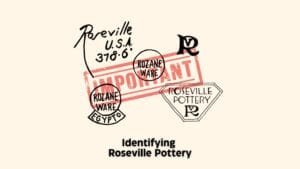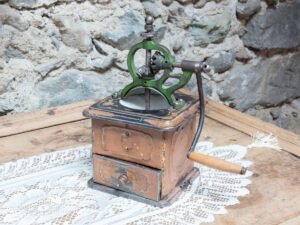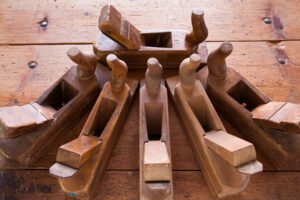If you have an old sled in your store, it’s time to dust it off and check its features because it can be worth quite a lot! Well, sleds have been around since the 17th Century. And old artifacts like these hit the eye of antique collectors worldwide!
So, your old rusty wooden sled might attract many eyes and be much more precious than you think! And today, I’ll tell you some cues to identify and value authentic antique sleds! Let’s get into it!
Key Takeaways
- You can spot antique sleds by their solid wood body, blunt ice-blades, and designer runners. You can also look for uneven edges and faded finishes on their seats and brush bows.
- Simple, flat-runner sleds are more valuable than thin or striped ones. But limited-edition shapes like swan, birds, or horses are equally precious.
- For a good value, pick orange, brown, black, or white sleds. Similarly, wooden sleds —maple, walnut, and hickory—are good choices.
- Exclusive Walt Disney or Tobboganer sleds are rare and costly. But you must maintain their original finishes and paints for good value. Want more tips on the same? Just scroll below, and I’ll tell it all!
Notable Identification Features of a Vintage Sled
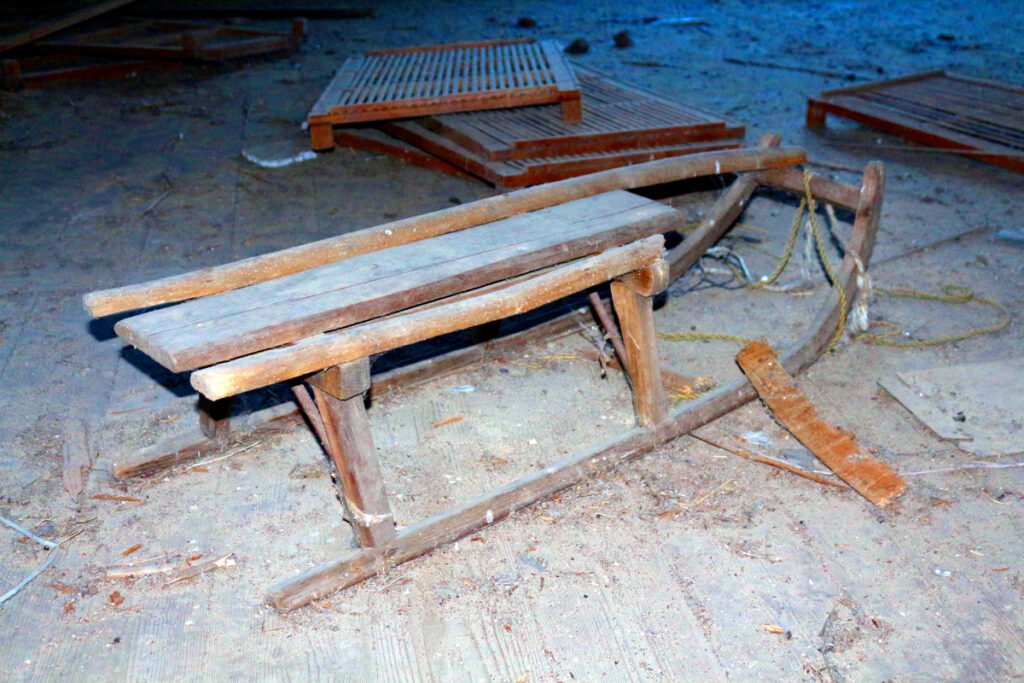
Imagine your regular sled with a hand-painted body, aged brackets, and screws. That’s what an antique sled looks like!
Most sleds will also have an etched logo and date that tracks their age and brand. Apart from that, you can spot them with long-runner seats and cargo beds!
What to Look for in a Vintage Sled?
- Painted seats and brush bows with regional flower or fruit motifs
- Unique animal-shaped runners with sculpted eyes and mouth
- Oak or Birch wood construction with cast-iron frames and claw brakes
- Uneven woodwork and a composite body with hand-screwed joints
- 3-5 feet runners with carved or stamped logs
Evolution & History of Sleds
Antique sleds first popped in the 16th Century AD. But they were heavy and didn’t last long. So, they were less popular back then. It was in the 1800s that makers made sturdier and fancier sleds! And that’s how sledding evolved as an everyday sport!
Then came the steel-hinged sleds of the 1850s. They were aesthetic, hand-made, and had single seats and cargo baskets. So they were portable and easy to store. Plus, most of the sled brands were in Paris; giving the ornate carvings and high value!
However, the sled industry suffered with the Great Depression in the 1920s. You can get some sleds from the 1900s, but they might have a low value. So, it’s better to check them beforehand!
4 Types of Old Sleds With Values
Antique sleds have distinct materials and carvings. So, each obviously has a different size, functionality, and worth. Let’s learn more about these types!
1. All-Wood Sleds
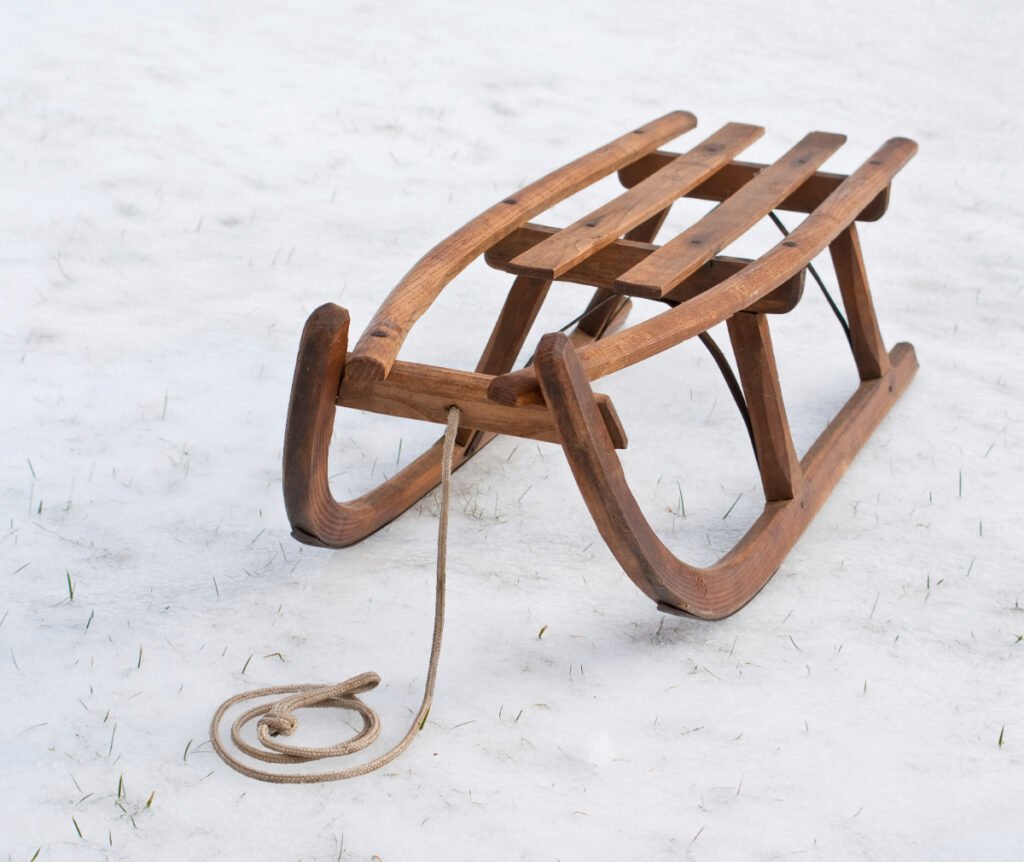
As the name suggests, all-wood sleds are sturdy oak sleds with wood runners and seats. They’re not that rare but have old handmade polishes that increase their worth.
You can also find regional motifs and carvings on these. Since these sleds are old, you can expect them to be valued at $300 – 400.
2. Metal Runner Sleds
Metal runner sleds have a composite construction. Like, you’ll see wood seats, metal runners, and cast iron joinery with this one!
You’ll also find curvier forms, brackets, and sharper ice-cutting blades. But since they are prone to rust and mold, they cost less, only around $200 – 400.
3. Tobogganers
Tobogganers are original Canadian military sleds you can identify with their defense-like body, runner-less boards, and curved brush bows. They will also have thicker material, wider baseplates, and screwed joints. So, you can expect a value of $500 – 700 for one!
4. Push Sleds

Do you remember the Christmas sled from the Ice Age movie? The push sleds look the same! You can see some upholstered chairs, bars, and metal runners with them. Plus, they’re more attractive and have exclusive hand-painted finishes.
But push sleds are tiny and suitable for gentle slopes or children’s use, so they’re cheaper, costing around $100 – 200.
6 Factors to Identify and Value Antique Sleds
Old sleds typically cost $500 – $2000, depending on their size, age, and materials. Flat-runner wooden sleds with oak or pine seats usually have the highest valuation. The resale value of an antique sled obviously changes with the brand and color. But, there are many other factors that impact its value!
1. Antique Sled’s Age
The larger the seat, the older and more precious the sled! Most 1700s sleds measure around 23-25 inches. They are really heavy and have about 2-3 push bars for balance. They also use sturdier seasoned wood, costing $4000 – 5000 in total.
Similarly, sleds from the 1800s cost more due to their curved brush bows and storage racks.
But sleds from the 1900s aren’t that intricate and costly. They have a thin, composite body and smaller seats and runners. Plus, most of them are factory-made, which makes them ordinary. Hence, the low demand and value.
How Do You Identify Sleds from the 1700s?
You can spot the 1700s sleds by their maple finish, hand-painted seats, and polishes. Most will have a flat bow brush and wood ice-cutting edges, but you can see wavy profiles too. Just look for traces of oil or lacquer for an olden make!
But these sleds won’t have a brand. So, you must look for stamped dates and joinery details to track their age. Nonetheless, they’re very precious, fetching you a value of $4000 – 5000.
How Do You Spot Sleds from the 1800s?
Look out for curved bow brushes, geometrical runners, and slatted seats to spot these! Most will have a label or logo, or you can look for cast iron trims and screwed joints to spot these. They’ll also have an upholstered seat and storage, costing $2000 – 3000 each.
How Do You Identify Sleds from the 1850s?
Spotting these sleds is a piece of cake! Just look for animal-shaped runners, slatted seats, steel frames, and you’re done! You can even find some regional paintings and motifs with these. The 1850s sleds cost about $3000 – 4000.
How Do You Spot Sleds from the 1900s?
You can spot these sleds by their steel runners, metal bodies, and sharp ice-cutters. You might even find some support bars, caskets, and trademark numbers to spot them. But, they will be more common and cheaper, at $100 – 200.
Let’s look at some common sled trademark numbers:
| Year | Sled Age | Trademark Number | Sled Type | Average Valuation |
| 1888 | 134 years | 381665 | Fairy Coaster Sled | $5000 – 6000 |
| 1889 | 133 years | 408681 | Distressed Sled | $1800 – 2000 |
| 1900 | 122 years | 5810376 | Racer Sled | $600 – 1000 |
Pick locally built oak or beech sleds with flat or triangle fronts for an old make.
2. Runner Shape
Antique sled runners weren’t always stripped and curved as they are today. In fact, most olden runners were flat with a log-like profile. And these simple, spindled models are in high demand today!
Then came the animal or nature-themed runners of the 1800s. Swans, Dragons, Birds, Horses, you name it, and you have it! You’ll obviously have a high value for these unique and rare shapes.
The later 20th-century runners are more minimal and stripped. They were made after the Industrial Revolution when demand was already low, so these sleds wouldn’t be worth much.
| Shape of the Runner | Average Valuation |
| Flat, Log-like, or Cuboidal | $4000 – 5000 |
| Curved, Wavy, Spindled | $3000 – 4000 |
| Rail, Cross, Skateboard-like | $2000 – 2500 |
| Swan, Bird, Dragon | $1000 – 2500 |
| Horse, Serpent, Elephant | $1000 – 2000 |
| Plain, or Tubular | $500 – 600 |
| Striped or Geometric | $100 – 200 |
3. Runner Color

The more wood tones, the higher the sled value! So, old wood, beige, or yellow runners from the early 1700s are highly precious. Even limited-edition colors – red, emerald, and gold, fetch a good value.
In contrast, sleds from the 1900s are mostly made from metal. They no longer have the handmade touch but are galvanized in greens and silver. And such machine-made sleds have a low value of $300 – 400.
Let’s look at the average value of some popular sled runner colors.
| Color of the Runner | Average Valuation |
| Wood, Orange, Brown, Yellow | $1000 – 1200 |
| Black, White, Chrome | $800 – 900 |
| Red, Emerald, Gold | $900 – 1000 |
| Bright Green, Blue, Coastal | $600 – 700 |
| Silver, or Pewter | $400 – 450 |
Avoid buying polished silver or aluminum runners as these might be new and cheaper.
4. Seat Materials

Solid wood sleds with bone handles usually get the best valuation. These also come with hide or natural leather seats and caskets. This makes them even rarer and more precious worldwide.
Similarly, engineered seats from the 1800s are famous for their dark stains. So, hickory, oak, or walnut sleds will get a a high value. You can even find intricate carvings and other moldings.
In contrast, steel or aluminum sleds from the 1900s are machine-made and cheaper. You might get upholstered seats with these, but they are not in demand that much!
| Sled Materials | Year | Average Valuation |
| Bone, Hide, Solid Wood, Leather | 1700 | $900 – 1000 |
| Hickory, Oak, Cherry, Walnut | 1800 | $800 – 900 |
| Maple, Pine | 1800 | $600 – 700 |
| Cast Iron, Alloyed Steel | 1850s | $500 – 600 |
| Galvanized Steel, Aluminum, Titanium | 1900s | $100 – 120 |
| Upholstered – Cotton, Polyester | 1900s | $100 – 120 |
5. Branding

Like any other brander product, branded antique sleds are always expensive! In fact, branded sleds are more durable, long, and support up to 4 riders.
They are also more aesthetic and have designer seats and animal-shaped runners. Plus, they also come with elegant diamond-back graphics and stamped logos on their sides.
You can also find some foreign influences and standardized safety rails with these. So naturally, they are more popular and earn a high value.
Here are some popular sled brands for reference:
| Sled Name | Manufacturer | Key Features | Average Valuation |
| FF Flyer Fly | Flexible Flyer | A 1980s-built oak body with ivy, berries, and rail motifs. Slatted seats with storage racks at the bottom | $900 – 1000 |
| Meteor Wooden Snow Sled | Hiawatha | A hickory wood body with alloyed steel runners, short walls, and bright red seats | $700 – 800 |
| Toboggan Brass Tag Sled | Paris Manufacturing Company | Oakwood body with metal frames, green seats, and screwed panels | $600 – 700 |
6. Rarity
The unique and patterned the runners, the rare the sled!
That means royal-family, foreign sleds are rare and pricey. And even old Walt Disney sleds, just like those in Frozen, are trendy and limited. These sleds are fancy and have reindeer runners and seats. So, they are a favorite among children and cost as high as $2000.
Here are some more vintage sleds for every antique collector!
| Name of the Sled | Manufacturer or Period | Average Valuation |
| Mickey Mouse Sled | Walt Disney | $2500 – 3000 |
| Horse Drawn Sled | Maple Syrup | $5000 – 6000 |
| Albany Cutter Sled | Ancient American Civilization | $9000 – 9500 |
| Slatted Flyer Sled | Strand Ski Company | $900 – 1000 |
4 Expert Tips to Value Antique Sleds!
- Pick asymmetrical handmade and hand-painted sleds for a better value.
- Avoid buying sleds with visible damage, chips, or faded finishes as they will be cheaper.
- Pick about 3-5 feet sleds for an old, branded make.
- Check the sled’s metal plates, tracks, and seats to locate the stamp and logo properly.
What Wood Are Antique Sleds Made Of?
Antique sleds are typically made of solid ash, beech, or oak wood. But you can even find some models carved in conifer tree woods like Pine, Spruce, and Fir. Reddish Cherry Oak and Maple are also common in the later 1850s models.
How Do You Clean Antique Sleds Properly?
You can clean antique sleds by scrubbing off the dirt with a mild detergent and soft bristle brush. You can also power wash them with a hose and scrub. But be sure to dry them properly to prevent the paintings from peeling.
Antique sleds are a popular collectible thanks to their unique shapes and colors. Old, handmade wood sleds will obviously be precious. But you can also buy red, gold, or oak sleds for good value. Once you get one, check our guide above and value it correctly!
But remember to check the sled for any cracks and chips to avoid losing value. The same holds true even for other vintage items like antique knives and antique-cut glass patterns. Jump to our guides for more information on the same.
Note: This article is intended for informational, educational, and entertainment purposes only. Some images are illustrative and may not represent actual brands, products, or related entities. All trademarks, product names, brand logos, packaging, and other intellectual property referenced remain the exclusive property of their respective owners. Any brand mentions or references are provided solely for descriptive and educational context and do not imply any formal or commercial association.





